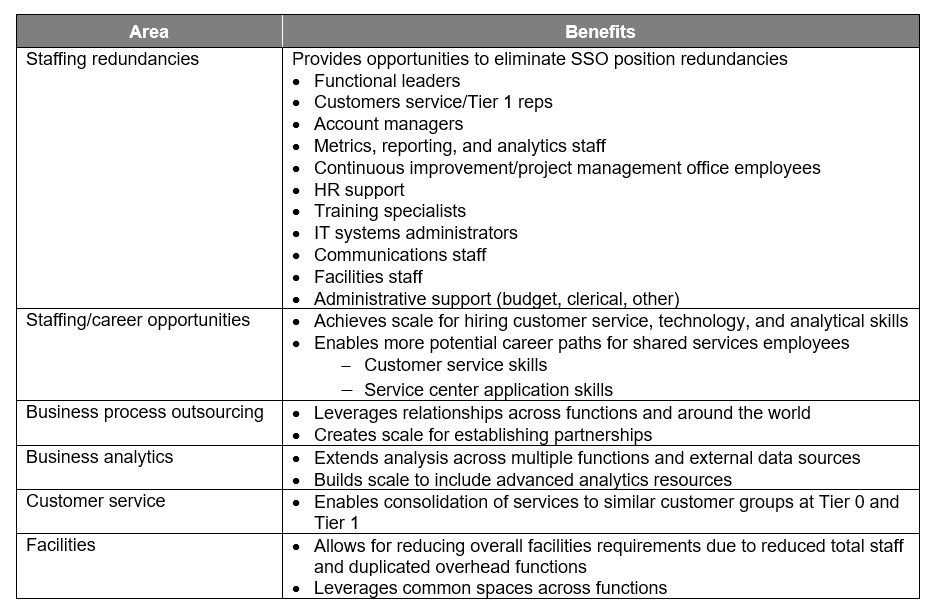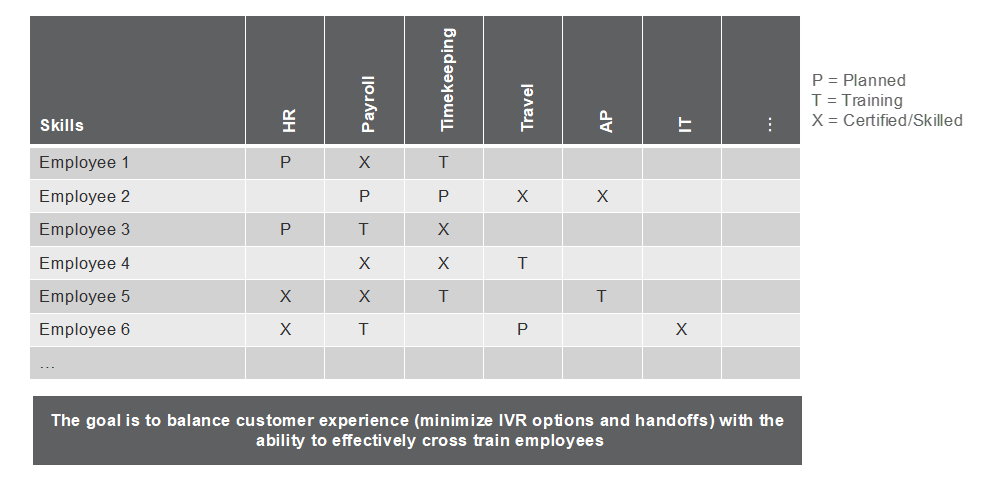
Shared services has come a long way since the early 90s when major corporations, such as Proctor and Gamble, adopted the approach to improve services and reduce overhead. Companies today are moving further to gain additional savings, capitalize on analytics, and leverage infrastructure by creating or consolidating services into multifunction shared services organizations.
Our experience working with shared services organizations validates that multifunctional organizations offer significant advantages beyond single-function models. Multifunction shared services reduce management overhead, employ common customer service functions, and leverage operational support and technologies across functions to deliver improved service at reduced costs. Moreover, multifunctional shared services facilitate process harmonization and end-to-end process integration with one management philosophy. The table below highlights a few of the advantages of incorporating multiple functions into one shared services model.


The implementation of multifunctional shared services does not come without challenges. When you venture across functional boundaries, sometimes you disrupt highly integrated single-function organizations that perceive themselves as experts at delivering high-quality services at low costs. While the existing standalone functions may perform well, looking at broader opportunities can enable even higher levels of efficiency and customer service. Next, we examine several common challenges that arise with the transition to multifunction.
How do I decide who will lead and where the organization will report?
The multifunction shared services leader must understand the various services within his or her portfolio and be an excellent team builder. Equally important, this leader must understand and value high-quality customer service, the levers of performance management, service-related technologies, and effective communications techniques. Knowledge of shared services models, principles, and expansion opportunities is often more important than specific functional knowledge, which can be gained through direct reports.
Though individual competence and leadership are important, many companies choose to organize multifunctional shared services under a non-parochial leader. The typical reporting relationship is to a president, the chief operating officer, or the chief strategy officer. Organizing under a function-specific executive (e.g., CIO, CFO, CHRO) ultimately leads to governance challenges as the functional executive now oversees unrelated functions that other executives are held accountable for (i.e., the CFO is responsible for accurate reporting, even if the shared services organization reports to a CIO).
What do I gain by consolidating service center support?
Each functional shared service requires common support functions such as quality management, training, metrics collection and reporting, vendor management, account management, continuous improvement, technology support, and others. Multifunctional organizations can improve depth and coverage for all functions by consolidating each of these services under one manager/supervisor. They can improve performance by adopting the best practices from each support area as they are consolidated. Finally, depending on the extent of redundancy of support across functions, these organizations may also reduce overall costs of internal support.
How do I enable a multifunctional Tier 1 customer support function without sacrificing customer service or first-contact resolution?
A prime tenet of excellent customer service is to add value on the first contact at the first tier in the service delivery model. Customers do not like dispatched service since that automatically adds a handoff. Multifunctional shared services can provide value on the first contact either by cross-training Tier 1 service reps across functions, routing contacts to the appropriate skill, or both. Both approaches work well. Cross-training increases depth while constraining costs, and skills-based routing assures that a service rep with the required skill (native or cross-trained) receives the contact.
Cross-training can be accomplished by initial deliberate training, or it can be developed over a period of time. Importantly, skills of service reps must be clearly documented and aligned with skills in telephony or multichannel queuing systems supporting the service center operations. The following table shows an example of a skills matrix that Tier 1 customer service management might use to track skills.

How do I get diverse teams to work together?

As with any major organizational transformation, change management is essential. The functional teams comprising the multifunctional shared service must understand the objectives and benefits of the initiative. Leadership should clearly outline expectations, make the critical staffing decisions, and define “what’s in it” for the employees.
Communications are essential throughout. These communications must be carefully timed. At a minimum, senior management should state when specific decisions will be made.
Breaking down the mindset of the traditional silos of finance, HR, IT, and supply chain takes time. Organizing end-to-end process teams with end-to-end process leaders can facilitate this shift in traditional thinking.
Implementation of multifunctional shared services provides significant value to companies willing to tackle the challenges. Customer experience can be enhanced while reducing supervisory overhead, combining operations support, and consolidating customer service. Finally, greater depth, scale, and flexibility to handle expansion or shifts in strategy are key reasons to begin this journey.
View MoreSussex Economic Advisors is now part of ScottMadden. We invite you to learn more about our expanded firm. Please use the Contact Us form to request additional information.